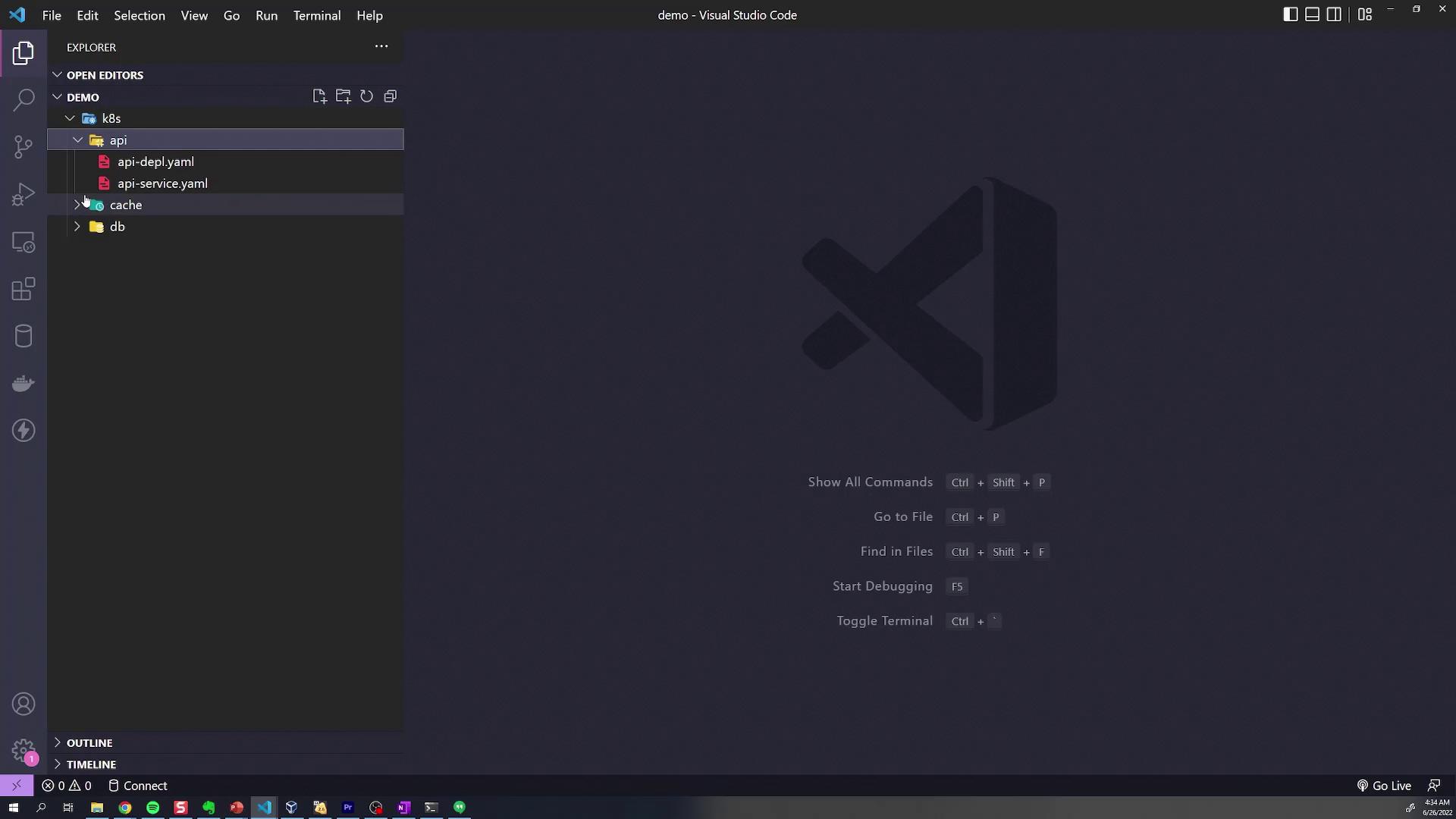CKA Certification Course - Certified Kubernetes Administrator
Kustomize Basics 2025 Updates
Managing Directories Demo
In this lesson, we explore how to effectively manage directories containing Kubernetes manifests. The demonstration uses a structured "K8s" directory that holds all Kubernetes configurations organized into three subdirectories: one for the API, one for the cache (acting as a readers' database), and one for the MongoDB database.
When you open the K8s directory, you'll see three distinct folders. Each folder includes configuration files (YAML manifests) tailored for a specific component. For instance, the database folder contains the deployment YAML files for MongoDB, while the API and cache directories contain configurations for services such as ClusterIP or LoadBalancer services along with associated ConfigMaps.

Below is an excerpt showcasing a typical service configuration for the cache component:
apiVersion: v1
kind: Service
metadata:
name: redis-cluster-ip-service
spec:
type: ClusterIP
selector:
component: redis
ports:
- port: 6379
targetPort: 6379
Before we introduce Kustomize, let's deploy these resources using the conventional approach without customization. Typically, you navigate into each directory and run the kubectl apply command as shown below:
kubectl apply -f k8s/api
# Output:
# deployment.apps/api-deployment created
kubectl apply -f k8s/cache
# (Applies cache-related configurations)
You can also deploy all configurations in one command by appending multiple -f flags:
kubectl apply -f k8s/api
kubectl apply -f k8s/cache
kubectl apply -f k8s/db
To delete all resources simultaneously, you can run:
kubectl delete -f k8s/db -f k8s/cache -f k8s/api
Note
Using multiple -f flags simplifies bulk deployment and deletion. However, as your infrastructure grows, managing these commands can become cumbersome.
Simplifying Resource Management with Kustomize
Kustomize makes it easier to manage and customize your application configurations. Begin by creating a kustomization.yaml file in the root of your K8s directory. This file specifies the API version and kind required by Kustomize:
apiVersion: kustomize.config.k8s.io/v1beta1
kind: Kustomization
Next, define the resources you wish to manage by listing the file paths relative to the kustomization.yaml file's location. For example:
apiVersion: kustomize.config.k8s.io/v1beta1
kind: Kustomization
resources:
- api/api-depl.yaml
- api/api-service.yaml
- cache/redis-config.yaml
- cache/redis-depl.yaml
- cache/redis-service.yaml
- db/db-config.yaml
- db/db-depl.yaml
- db/db-service.yaml
You can then build the complete set of manifests using the Kustomize CLI:
kustomize build k8s/
This command outputs the final Kubernetes manifests, combining configurations from the API, cache, and database folders. While kustomize build displays the resulting configuration, it does not apply it to your cluster. To deploy these resources, pipe the output to kubectl apply:
kustomize build k8s/ | kubectl apply -f -
Alternatively, leverage the built-in support for Kustomize in kubectl with the -k flag:
kubectl apply -k k8s/
After applying the configurations, verify that the resources have been successfully created by checking the pods:
kubectl get pods
Expected output:
NAME READY STATUS RESTARTS AGE
api-deployment-64dd567b46-1mw4c 1/1 Running 0 27s
db-deployment-657c8fbd8-vnjs7 1/1 Running 0 26s
redis-deployment-587fd758cf-7pt57 1/1 Running 0 26s
Tip
For quick troubleshooting, always verify your pods' status with kubectl get pods after deploying configurations.
Advanced Directory Structuring with Kustomize
While maintaining a single kustomization.yaml in the root directory works for simple projects, a more scalable practice is to include a kustomization.yaml file in each subdirectory. In this method, each directory imports only the YAML files specific to its component, while a root kustomization.yaml aggregates these directories.
API Directory Configuration
In the API folder, create a kustomization.yaml that lists the API deployment and service manifests:
apiVersion: kustomize.config.k8s.io/v1beta1
kind: Kustomization
resources:
- api-depl.yaml
- api-service.yaml
Cache Directory Configuration
In the cache directory, set up the following kustomization.yaml:
apiVersion: kustomize.config.k8s.io/v1beta1
kind: Kustomization
resources:
- redis-config.yaml
- redis-depl.yaml
- redis-service.yaml
Database Directory Configuration
Similarly, for the database directory, create a kustomization.yaml:
apiVersion: kustomize.config.k8s.io/v1beta1
kind: Kustomization
resources:
- db-config.yaml
- db-depl.yaml
- db-service.yaml
Root Directory Aggregation
Finally, update the root kustomization.yaml to reference these subdirectories. When a directory is specified as a resource, Kustomize automatically searches for a kustomization.yaml file inside:
apiVersion: kustomize.config.k8s.io/v1beta1
kind: Kustomization
resources:
- api/
- cache/
- db/
Before re-deploying, delete any previously applied resources:
kubectl delete -f k8s/db -f k8s/cache -f k8s/api
Then, build the final configuration with Kustomize:
kustomize build k8s/
Review the output to ensure it meets your expectations, then apply the aggregated configuration:
kubectl apply -k k8s/
The expected output should be similar to:
configmap/redis-credentials created
service/api-service created
service/db-service created
service/redis-cluster-ip-service created
deployment.apps/api-deployment created
deployment.apps/db-deployment created
deployment.apps/redis-deployment created
Verify the pods again:
kubectl get pods
Expected output:
NAME READY STATUS RESTARTS AGE
api-deployment-64dd567b46-1mw4c 1/1 Running 0 27s
db-deployment-657c8fbd8-vnjs7 1/1 Running 0 26s
redis-deployment-587fd758cf-7pt57 1/1 Running 0 26s
This structured approach using Kustomize not only centralizes the management of your Kubernetes configurations but also offers a scalable solution for handling an expanding set of resources within your infrastructure.
Watch Video
Watch video content
Practice Lab
Practice lab